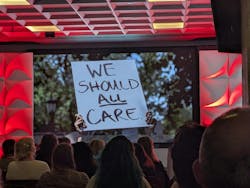Alice Rawsthorn at NeoCon 2025: Attitudinal Design Insights
Introducing the June 10 keynote during NeoCon 2025, ASID national board of directors chair David Euscher urged the architectural and design community to continue to expand their understanding of how intentional design enriches lives, and—with forward thinking prioritized—improves our global future.
Referencing ASID’s most recent trends outlook, Euscher flagged a growing erosion of trust in institutions, he said. However, as agile problem-solvers, designers are uniquely positioned to help heal these rifts. The design community must be increasingly “more responsive and responsible,” ensuring the best possible outcomes in a space, Euscher concluded.
When British design critic and author Alice Rawsthorn ascended the stage, she outlined a number of historic and contemporary challenges—and subsequent responses to those political, social, environmental, and wellness concerns that epitomized “design with an attitude,” or attitudinal design.
But First—What Is Design With An Attitude?
Rawsthorn explained that attitudinal design is a way of challenging design systems, rooted in Bauhaus pioneer László Moholy-Nagy’s belief that “designing is not a profession but an attitude” that influences all aspects of life and human experience.
As creative professionals who resolve issues of form, function, and feeling, she commercial interior designers can break convention by referencing a variety of disciplines to develop a proactive approach to emerging and long-term challenges. Here are five ways interior professionals can evolve an attitudinal design strategy.
Five Key Takeaways
1. Embrace a Mindset of Resourcefulness and Invention. Echoing the Bauhaus vision, Rawsthorn said, designers from all fields can find ways to adapt and reinvent in challenging times. For example, to assist during the Russia-Ukraine conflict, many Ukrainian fashion designers shifted their focus from clothing to sleeping bags and other supplies for the unhoused, as well as military apparel and gear.
2. Prioritize Well-being, Then Harmonize With Aesthetics. From the start of a project, commercial interior designers play a key role in determining what will foster positive human experience, productivity, and safety in conjunction with aesthetics. From product design to built environments, Italian designers Andrea Trimarchi and Simone Farresin of Formafantasma “examine problematic aspects of design” like global trade practices and waste, and are known for demonstrating “intellectual rigor” in their work, Rawsthorn noted.
3. Employ Humanistic and Humanitarian Principles. Draw inspiration from humanistic design approaches, focusing on creating spaces that are affordable, sustainable, and cater to the fundamental needs of all users, especially underserved populations.
4. Identify Big Challenges, Then Find Scalable Solutions. Design is a powerful tool for addressing turbulence and uncertainty in society, Rawsthorn said. Retired architect Yasmeen Lari envisioned flood-resistant housing for “the poorest of the poor” impacted by climate change, and her initiative exceeded a goal of building one million households by the end of 2024.
5. Seek Cross-Disciplinary Collaboration and Inspiration. Develop cross-disciplinary teams to solve complex problems when possible, Rawsthorn advised. As a start, draw insights from various fields to develop more holistic and effective commercial interior solutions.
*Updated June 12, 2025 12:30 PM for additional links.
About the Author
Carrie Meadows
Editor-in-Chief
Carrie Meadows is Editor-in-Chief of interiors+sources (i+s), where she leads editorial strategy, content development, and brand storytelling focused on the people, projects, and innovations shaping the design industry. With more than two decades of experience in B2B media, she has built a career connecting technical expertise with creative insight—translating complex topics into meaningful stories for professional audiences. Before joining i+s in 2024, Carrie served as Editor-in-Chief of LEDs Magazine within Endeavor Business Media’s Digital Infrastructure & Lighting Group, guiding coverage of emerging lighting technologies, sustainability, and human-centric design. Her earlier editorial experience spans across Laser Focus World, Vision Systems Design, Lightwave, and CleanRooms, where she managed print and digital publications serving the optics, photonics, and semiconductor sectors.
An advocate for clear communication and thoughtful storytelling, Carrie combines her editorial management, SEO, and content strategy expertise to help brands and readers stay informed in a rapidly evolving media landscape. When she’s not crafting content, Carrie can be found volunteering at a local animal shelter, diving into a good crime novel, or spending time outdoors with family, friends, and her favorite four-legged friends.


